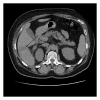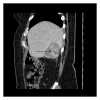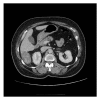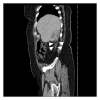A case of a ruptured sclerosing liver hemangioma
- PMID: 21994877
- PMCID: PMC3170855
- DOI: 10.4061/2011/942360
A case of a ruptured sclerosing liver hemangioma
Abstract
Hemangiomas are the most common benign tumors found in the liver, typically asymptomatic, solitary, and incidentally discovered. Although vascular in nature, they rarely bleed. We report a case of a 52-year-old woman with a previously stable hemangioma who presented to our hospital with signs and symptoms indicative of spontaneous rupture. We review the literature, focusing on diagnosis and management of liver hemangiomas.
Figures





Similar articles
-
Surgical Treatment of Giant Liver Hemangioma, Case Report and Literature Review.Sisli Etfal Hastan Tip Bul. 2019 Aug 28;53(3):318-321. doi: 10.14744/SEMB.2017.09815. eCollection 2019. Sisli Etfal Hastan Tip Bul. 2019. PMID: 32377104 Free PMC article.
-
Torsion of a Giant Pedunculated Hemangioma of the Liver Presenting With Acute Abdomen: A Case Report.Iran Red Crescent Med J. 2016 Jul 17;18(8):e38198. doi: 10.5812/ircmj.38198. eCollection 2016 Aug. Iran Red Crescent Med J. 2016. PMID: 27781125 Free PMC article.
-
Ruptured Hepatic Hemangioma in the Third Trimester of Pregnancy: A Rare Case Report.Cureus. 2022 May 27;14(5):e25397. doi: 10.7759/cureus.25397. eCollection 2022 May. Cureus. 2022. PMID: 35765393 Free PMC article.
-
[Giant hepatic hemangioma, an uncommon presentation of a frequent disease].Rev Gastroenterol Peru. 2018 Apr-Jun;38(2):201-203. Rev Gastroenterol Peru. 2018. PMID: 30118469 Review. Spanish.
-
Hepatic hemangiomas: the various imaging avatars and its mimickers.Radiol Med. 2020 Sep;125(9):801-815. doi: 10.1007/s11547-020-01185-z. Epub 2020 Apr 5. Radiol Med. 2020. PMID: 32249391 Review.
Cited by
-
Diagnosis and management of giant hepatic hemangioma: the usefulness of contrast-enhanced ultrasonography.Int J Hepatol. 2013;2013:802180. doi: 10.1155/2013/802180. Epub 2013 May 16. Int J Hepatol. 2013. PMID: 23762570 Free PMC article.
-
Giant Sclerosing Hepatic Hemangioma Presenting as Bornman-Terblanche-Blumgart Syndrome: a Case Report and Review of the Literature.Med Arch. 2023;77(4):314-318. doi: 10.5455/medarh.2023.77.314-318. Med Arch. 2023. PMID: 37876559 Free PMC article. Review.
-
A sclerosing hemangioma of the liver.Clin Mol Hepatol. 2013 Dec;19(4):426-30. doi: 10.3350/cmh.2013.19.4.426. Clin Mol Hepatol. 2013. PMID: 24459649 Free PMC article. No abstract available.
-
High-resolution micro-CT for morphologic and quantitative assessment of the sinusoid in human cavernous hemangioma of the liver.PLoS One. 2013;8(1):e53507. doi: 10.1371/journal.pone.0053507. Epub 2013 Jan 7. PLoS One. 2013. PMID: 23308240 Free PMC article.
-
Multiple hepatic sclerosing hemangioma mimicking metastatic liver tumor successfully treated by laparoscopic surgery: Report of a case.Int J Surg Case Rep. 2015;8C:137-40. doi: 10.1016/j.ijscr.2015.01.032. Epub 2015 Jan 21. Int J Surg Case Rep. 2015. PMID: 25679307 Free PMC article.
References
-
- Dietrich CF, Mertens JC, Braden B, Schuessler G, Ott M, Ignee A. Contrast-enhanced ultrasound of histologically proven liver hemangiomas. Hepatology. 2007;45(5):1139–1145. - PubMed
-
- Geschickter CF, Keasbey LE. Tumors of blood vessels. American Journal of Cancer. 1935;25:p. 568.
-
- Sewell JH, Weiss K. Spontaneous rupture of hemangioma of the liver. Archives of surgery. 1961;83:729–733. - PubMed
-
- Caseiro-Alves F, Brito J, Araujo AE, et al. Liver haemangioma: common and uncommon findings and how to improve the differential diagnosis. European Radiology. 2007;17(6):1544–1554. - PubMed
Publication types
LinkOut - more resources
Full Text Sources

